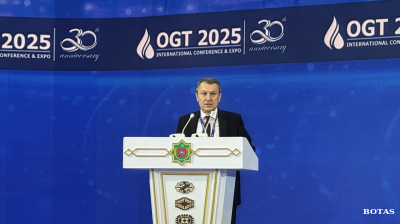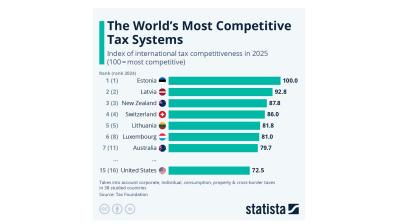Lithuania enjoyed robust growth in 2019 but this is forecast to decline in 2020 mainly due to external factors.
GDP growth in 2019 is seen in the 3.4-3.8% range according to forecasts from the European Bank for Reconstruction and Development (EBRD), the European Commission, the International Monetary Fund (IMF) and Swedbank.
This was helped by factors including better agricultural yields compared to 2018, which encouraged some economists to raise their initial forecasts for the year. During the year, growth was supported by “vibrant household consumption, investment and exports” according to the EBRD, which pointed to labour tax reforms that reduced the tax wedge in 2019, providing an additional boost to household spending, while investment growth remained strong as absorption of EU funds improves.
The latest data available from Statistics Lithuania shows that Lithuanian GDP growth came in at an adjusted 3.6% y/y in the third quarter, according to the statistics office’s first reading, which is just 0.4pp down on the previous quarter’s reading.
Consumer price inflation is expected to come in at 2.3% in 2019 and 2.2% in 2020, according to the IMF.
Looking ahead, the consensus is that Lithuania is heading for a slowdown in 2020.
The IMF projects growth will decline to 2.7% in 2020; the European Commission projects 2.4% growth; and, the EBRD is even less optimistic at 2.3%, having revised its forecast downwards when releasing its latest Regional Economic Prospects report in late 2019.
“Given the weak external environment expected in 2020 and 2021, growth is forecast to rely on domestic demand developments and is therefore projected to moderate to 2.4%,” said the European Commission in its Autumn Forecast.
According to Swedbank, “[In 2020] growth will slow down further as global weakness will persist. While immediate risks related to Brexit have abated, it can still bring surprises [in 2020]. We do not expect a temporary ceasefire between the US and China to bring meaningful resolution to trade conflict and there is also the looming threat of auto tariffs.”
Concerning uncertainty surrounding Brexit, the EBRD notes that Lithuania and neighbouring Latvia are the EU’s largest exporters of wood and food products to the UK, though exports of final and intermediate goods from the eastern part of the EU to the UK are relatively modest.
Rating agency Fitch, which expects GDP growth to come in at around 2.5% in 2020-2021, says there are already some signs of a slowdown as growth of retail sales slowed down slightly to 4.2% in October, and industrial production declined 2% y/y on a calendar-adjusted basis the same month.
In the medium-term, the main risks to Lithuania’s outlook are structural factors and demographics.
The labour market crisis that has afflicted countries across Central and Eastern Europe is already contributing to the incipient growth slowdown in Lithuania, and companies are investing into automation in response. "Greater investment in productivity could partially offset negative demographic trends associated with ageing and emigration,” said the EBRD.
However, in a sign that the labour crisis is easing, the European Commission points out that immigration is set to exceed emigration in the coming years. “Though the number of vacancies remains high, to some extent, workers from non-EU countries are helping to ease labour shortages, especially in the transportation and construction sectors,” it says. Unemployment is expected to remain at around 6.2%, and the labour market will remain tight, driving up wages.
In terms of sectors, Lithuania has seen expansion in emerging areas such as tech and renewables.
While Lithuania hasn’t yet achieved the successes of Estonia in the tech sector, it has become something of a rising star. A Lithuanian company, Voltas IT, topped the latest Deloitte CE Fast 50 ranking of the fastest growing tech companies from the region, and Lithuania was the highest ranked country from the region on the latest Digital Quality of Life (DQL) survey published by online privacy specialist Surfshark. And Lithuania got its first unicorn — a tech startup valued at over $1bn — used clothing marketplace Vinted, in 2019.
Lithuania is looking to boost wind energy generation in particular following the adoption of the new National Energy Strategy in 2018, that has a strong emphasis on renewables. The country’s target is for renewables to make up 45% of its power mix by 2030. Among the investment plans for the sector, European Energy A/S plans to build 500 MW of wind farms at three sites in Lithuania, as reported in November.
Another election year ahead
Like 2019, which saw the election of former banker Gitanas Nauseda as president, 2020 is an election year with the next parliamentary elections due to take place in October.
Prime Minister Saulius Skvernelis said after failing to reach the run-off in the presidential election in July 2019 that he would stand down, but he later changed his mind and remains in the position. He continued working through 2019 despite receiving treatment for lymphoma.
Skvernelis and his coalition government have been hit by scandals recently. At the beginning of December, Nauseda called on Skvernelis to ask the ethics commission to look into a decision to allocate around €150,000 to pave a street close to the prime minister’s home. Transport and Communications Minister Jaroslav Narkevic has also been criticised for his decision to fire the management board of Lithuanian Post.
A survey by Vilmorus, published by daily Lietuvos Rytas, found in November that less than a quarter of the population trust political parties, with a strong loss of confidence since the previous month. 60.9% distrusted the parliament and 29% didn’t trust the government. The president got a higher rating with 64% saying they trusted him — but not as high as the 91.6% who said they trusted firefighters.
Concerning relations with its neighbours, Nato member Lithuania, like the other Baltic states, has troubled relations with Moscow, although Russia is Lithuania’s largest individual trade partner,
There are also tensions between Vilnius and Minsk over Belarus’ construction of the Astravyets Nuclear Power Plant. Construction of the plant has raised safety fears in Lithuania, but Vilnius hasn’t managed to get the other Baltic states on board for a boycott of electricity produced at the plant.
Modest budget surplus planned for 2020
Lithuania’s 2020 state budget is planned with a modest general government surplus of 0.2% of GDP.
The central government's budget revenue is projected to grow by 9% year-on-year to €11.545bn, while spending is planned to increase by 8% to €12.646bn, local media reported as the bill was submitted to parliament. It was adopted by the parliament — despite vocal objections from the opposition — on December 18.
Among the key areas of spending, the budget bill envisages an extra €327mn on pensions and €149mn to increase monthly child benefit. On the revenues side, the bill set out an increase in excise duties on strong alcohol, tobacco and fuel, a levy on polluting cars and an expansion of the real estate tax base.
Ahead of the budget’s adoption the government was under heavy pressure to increase spending in various areas. Notably, teachers staged a warning strike in December that brought back unhappy memories of the strikes last year that forced out Lithuania’s then education minister. University professors in Vilnius also staged a walkout to demand more money. Meanwhile, farmers protested against plans to raise taxes on fuel.
In future, Lithuania is expected to receive less money from the EU, while its contributions will grow. The country has also committed to spending 2.5% of GDP on defence until 2030.
Lithuania’s government debt is modest and has been on a downward trend since 2015.
The European Commission expects the debt-to-GDP ratio to remain “rather stable” in the next few years. Lithuania has already accumulated pre-financing in preparation for a bond redemption in early 2020, slightly raising the debt-to-GDP ratio to 36.3%, up from 34.1% in 2018. “The positive effect of the scheduled bond redemption is set to be somewhat counterbalanced by a continuous accumulation of necessary funds for the same exercise in 2021 and 2022,” said the European Commission in its 2019 Autumn Report.
Rating agency Fitch forecasts general government gross debt (GGGD) to increase to 37% of GDP in 2019, reflecting the pre-financing of the bond maturing in February 2020, before falling to 35.1% of GDP by 2021 due to sustained primary surpluses.
Fitch noted when affirming the country’s Long-Term Foreign-Currency Issuer Default Rating (IDR) at 'A-' with a Positive Outlook in August 2019 that Lithuania has a favourable debt structure and dynamics are relative to its peers, with lower interest payments (2.6% of government revenues against the current A median of 4.0%) and long maturities (a weighted average maturity of 8.0 years).
A resilient banking sector but risks ahead
The latest asset quality review of the sector published by Lietuvos bankas in August 2019 noted that banks have been profitable and remained resilient to external shocks; “Stress testing reveals that banks operating in Lithuania would manage to withstand a significant economic downturn,” the report said.
However, the report also pointed to the “significantly high” concentration within the sector, which raises the systemic importance of individual banks, and may have contributed to the increase in interest rates on new household and corporate loans.
“The key risks to the stability of Lithuania’s financial system are the potential correction of imbalances in the Nordic countries and the formation of a potentially unsustainable financial cycle in Lithuania,” the report said.
Such an event could result, for example, from “the deteriorating external environment, increase in risk premia in global financial markets and concerns over the alleged money-laundering transactions through certain Nordic banks. The second systemic risk relates to Lithuania’s booming credit and [real estate] markets.”
The Baltic banking sectors have been tarnished by a series of scandals over the last few years, though in 2019 the focus was on Estonia and Latvia rather than Lithuania.
This has caused some of the major Scandinavian banking houses, some of which have been at the heart of recent scandals, to review their commitments to the region. Danske Bank announced its exit from the Baltic states in February 2019, and three months later Handelsbanken said its Baltic business was “not worth the cost”. However, Swedbank extended its commitment to Lithuania, buying up Barclays’ financial technology centre, Rise Vilnius, in May 2019.
The Lithuanian authorities were mulling various steps affecting the banking sector as of the end of 2019.
The government appears to have cooled on the previously mooted plan for a banking asset tax, but under the 2020 budget, the corporate tax for banks is being raised from 15% to 20%.
The same committee has also put forward the idea of setting up a state commercial bank, and President Gitanas Nauseda has spoken in favour of the idea.
Features

Washington has a new focus on a Caspian energy play
For most of the last three decades since winning independence, Central Asia has been a bit of a backwater. Not any more. The Trump administration is becoming more focused on Turkmenistan's vast gas reserves and can smell money and power there.

BOTAŞ and Turkey’s hub ambition: from “30-year dream” to cross-border reality
For Ankara, the symbolism is as important as the molecules: Turkey’s energy map is shifting from end-market to hub.

Indian bank deposits to grow steadily in FY26 amid liquidity boost
Deposit growth at Indian banks is projected to remain adequate in FY2025-26, supported by an improved liquidity environment and regulatory measures that are expected to sustain credit expansion of 11–12%





